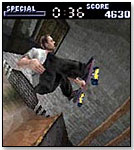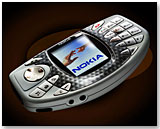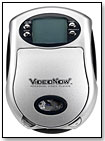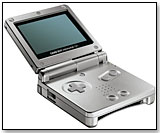 Tapwave’s Zodiac |
Portability is the new frontier for digital entertaiment. 2003 witnessed a confluence of wireless technology, digital imagery and video game sophistication that has made it possible for gamers to duel with someone on another continent while riding the bus, or watch their favorite Yu-Gi-Oh! episode on a pocket-sized video player. So get yourself some cargo pants and AA batteries; you won’t be home for a while.
Zodiac’s a Killer
 SpyHunter on Zodiac |
Tapwave’s Zodiac is a sleek 6.3-ounce anodized aluminum hand-held gaming system--available in 32 and 128 megabyte versions ($299 and $399)--that’s brand new to the portable market. Besides gaming capability, Zodiac features Bluetooth wireless capability and numerous other PDA features, including MP3 and video.
“Bluetooth creates a social experience,” said Byron Connell, co-founder and VP of marketing for Tapwave. “You can hang out with your buddies at Starbucks playing games.”
Given Zodiac’s PDA features and price point, it’s not hard to spot the device’s rival for the 18-34 gamer crowd.
“N-Gage is clearly going after the same market,” said Connell. “But we chose not to converge the [cell phone and gaming] technologies. We saw it as problematic. A phone should be a communication device first.
“The problem with cell phone gaming,” he continued, “is that the latency is very bad. If you’re playing a fighting game with someone, by the time you throw a kick—he’s already moved.”
Connectivity comparisons aside, it’s the rich graphics and responsive controller of the Zodiac that have been drawing raves from reviewers. At 480x320, the Zodiac’s screen offers four times the resolution of both N-Gage and Gameboy, and its two processors—a Motorola ARM 9 and an ATI Imageon graphics accelerator—help put the “D” in 3-D.
“We tried to incorporate the X-box’s joystick, and then realized we had to do a custom design,” said Connell. “The analog controller is pressure sensitive and allows for 360 degrees of true motion.”
 Tony Hawk’s Pro Skater |
Available games include Tony Hawk’s Pro Skater 4, Doom II and SpyHunter. “We’ve been bombarded by third parties with proposals for retro games,” Connell said. “There’s a real demand for the older games from adult gamers.” Tapwave is negotiating deals with both Sega and Midway to run the Genesis and Commodore 64 engines on the Zodiac.
Currently available at Tapwave’s website, Connell predicts Zodiac will be in retail outlets by Spring 2004.
N-Tirely New Way to Play
As the world’s largest cell phone manufacturer, Nokia knows its target consumer. “N-Gage is clearly not a device for children,” said Denise Crew, spokesperson for Nokia. “It was designed for the 18 to 35-year-old hardcore active gamer. It would be wrong to compare N-Gage to Gameboy.”
 Nokia ’s N-Gage |
N-Gage, a portable gaming device that also functions as a cell phone, PDA, FM radio and MP3 player, was launched on Oct. 7, 2003, and went on to sell 400,000 units in its first two weeks. Unlike the simple games offered on ordinary cell phones, N-Gage offers games with advanced graphics on swappable cards, such as Tomb Raider, Tony Hawk’s Pro Skater and Sonic N (developed specially for N-Gage).
“N-Gage brings an entirely new platform of game-play,” said Crew, describing the N-Gage Arena, an online gaming community that can be accessed via Bluetooth or the new GPRS (General Packet Radio Service). Currently there are 20 games available, with Crew predicting 100 games being offered by the end of 2004.
Gaming websites are posting mixed reviews for N-Gage. While lauding its compact size and excellent graphics, many gamers complain that the screen is undersized, and that having to remove the battery to change game cards is a hassle. Retailing at $299, compared to chief competitor Gameboy’s $100 price tag, N-Gage’s immediate success will hinge upon the popularity of its wireless gameplay capability, something Gameboy cannot challenge.
“This is definitely the beginning of something new,” said Crew. “We are completely committed to this market.”
Video Comes to the Toy Aisle
 Hasbro’s Video Now |
Also new in Oct. 2003, Hasbro’s Video Now ($49.99) brings portable video to the Tween consumer. Video Now Players are pocket-sized at 4”x6”, with a black and white screen measuring 1.7” by 1.3”, and utilize a proprietary 3-inch disc containing 30 minutes of content, featuring current favorites such as SpongeBob Squarepants, Jimmy Neutron, Fairly Odd Parents and a special “A Day in My Life” starring Hillary Duff.
Future discs are scheduled to include The Discovery Channel’s Shark Week, full-length episodes of Fear Factor and original content from BMX pro Jamie Bestwick and skateboarder Eric Koston.
Hasbro plans to introduce 20 new titles each quarter, with single discs retailing at $7.99, or $14.99 for a 3-pack. Two AA batteries power the player for seven hours of continuous play.
 Gameboy SP |
Video Now’s rival for Tween dollars is 4Kids Entertainment’s new GBA-TV, which allows kids to watch episodes of their favorite anime shows—Pokemon, Yu-Gi-Oh! et al.—on their Gameboy Advance and Gameboy Advance SP portable systems. 4Kids will sell cartridges containing two episodes for under $20, and best of all, there’s no adapter required. Besides the price, GBA-TV has the advantage of full color video and a ready consumer base of 12 million Gameboy Advance owners.

